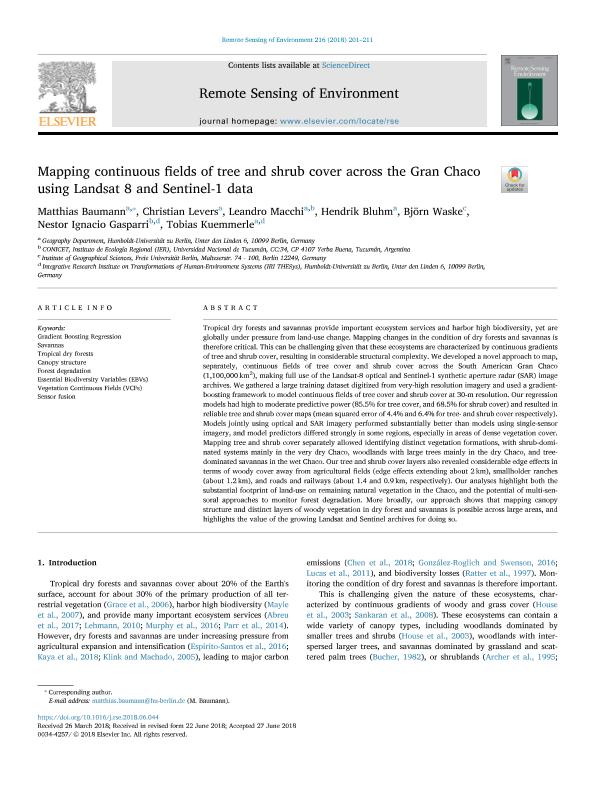Mostrar el registro sencillo del ítem
dc.contributor.author
Baumann, Matthias

dc.contributor.author
Levers, Christian
dc.contributor.author
Macchi, Leandro

dc.contributor.author
Bluhm, Hendrik
dc.contributor.author
Waske, Björn
dc.contributor.author
Gasparri, Nestor Ignacio

dc.contributor.author
Kuemmerle, Tobias

dc.date.available
2019-11-25T23:10:06Z
dc.date.issued
2018-10
dc.identifier.citation
Baumann, Matthias; Levers, Christian; Macchi, Leandro; Bluhm, Hendrik; Waske, Björn; et al.; Mapping continuous fields of tree and shrub cover across the Gran Chaco using Landsat 8 and Sentinel-1 data; Elsevier Science Inc; Remote Sensing of Environment; 216; 10-2018; 201-211
dc.identifier.issn
0034-4257
dc.identifier.uri
http://hdl.handle.net/11336/90415
dc.description.abstract
Tropical dry forests and savannas provide important ecosystem services and harbor high biodiversity, yet are globally under pressure from land-use change. Mapping changes in the condition of dry forests and savannas is therefore critical. This can be challenging given that these ecosystems are characterized by continuous gradients of tree and shrub cover, resulting in considerable structural complexity. We developed a novel approach to map, separately, continuous fields of tree cover and shrub cover across the South American Gran Chaco (1,100,000 km2), making full use of the Landsat-8 optical and Sentinel-1 synthetic aperture radar (SAR) image archives. We gathered a large training dataset digitized from very-high resolution imagery and used a gradient-boosting framework to model continuous fields of tree cover and shrub cover at 30-m resolution. Our regression models had high to moderate predictive power (85.5% for tree cover, and 68.5% for shrub cover) and resulted in reliable tree and shrub cover maps (mean squared error of 4.4% and 6.4% for tree- and shrub cover respectively). Models jointly using optical and SAR imagery performed substantially better than models using single-sensor imagery, and model predictors differed strongly in some regions, especially in areas of dense vegetation cover. Mapping tree and shrub cover separately allowed identifying distinct vegetation formations, with shrub-dominated systems mainly in the very dry Chaco, woodlands with large trees mainly in the dry Chaco, and tree-dominated savannas in the wet Chaco. Our tree and shrub cover layers also revealed considerable edge effects in terms of woody cover away from agricultural fields (edge effects extending about 2 km), smallholder ranches (about 1.2 km), and roads and railways (about 1.4 and 0.9 km, respectively). Our analyses highlight both the substantial footprint of land-use on remaining natural vegetation in the Chaco, and the potential of multi-sensoral approaches to monitor forest degradation. More broadly, our approach shows that mapping canopy structure and distinct layers of woody vegetation in dry forest and savannas is possible across large areas, and highlights the value of the growing Landsat and Sentinel archives for doing so.
dc.format
application/pdf
dc.language.iso
eng
dc.publisher
Elsevier Science Inc

dc.rights
info:eu-repo/semantics/openAccess
dc.rights
Atribución-NoComercial-CompartirIgual 2.5 Argentina (CC BY-NC-SA 2.5 AR)
dc.rights.uri
https://creativecommons.org/licenses/by-nc-sa/2.5/ar/
dc.subject
CANOPY STRUCTURE
dc.subject
ESSENTIAL BIODIVERSITY VARIABLES
dc.subject
FOREST DEGRADATION
dc.subject
GRADIENT BOOSTING REGRESSION
dc.subject
SAVANNAS
dc.subject
SENSOR FUSION
dc.subject
TROPICAL DRY FORESTS
dc.subject
VEGETATION CONTINUOUS FIELDS
dc.subject.classification
Ciencias Medioambientales

dc.subject.classification
Ciencias de la Tierra y relacionadas con el Medio Ambiente

dc.subject.classification
CIENCIAS NATURALES Y EXACTAS

dc.subject.classification
Ecología

dc.subject.classification
Ciencias Biológicas

dc.subject.classification
CIENCIAS NATURALES Y EXACTAS

dc.subject.classification
Silvicultura

dc.subject.classification
Agricultura, Silvicultura y Pesca

dc.subject.classification
CIENCIAS AGRÍCOLAS

dc.title
Mapping continuous fields of tree and shrub cover across the Gran Chaco using Landsat 8 and Sentinel-1 data
dc.type
info:eu-repo/semantics/article
dc.type
info:ar-repo/semantics/artículo
dc.type
info:eu-repo/semantics/publishedVersion
dc.date.updated
2019-10-16T20:58:19Z
dc.journal.volume
216
dc.journal.pagination
201-211
dc.journal.pais
Estados Unidos

dc.description.fil
Fil: Baumann, Matthias. Universität zu Berlin; Alemania
dc.description.fil
Fil: Levers, Christian.
dc.description.fil
Fil: Macchi, Leandro. Universidad Nacional de Tucumán. Instituto de Ecología Regional. Consejo Nacional de Investigaciones Científicas y Técnicas. Centro Científico Tecnológico Conicet - Tucumán. Instituto de Ecología Regional; Argentina. Universität zu Berlin; Alemania
dc.description.fil
Fil: Bluhm, Hendrik. Universität zu Berlin; Alemania
dc.description.fil
Fil: Waske, Björn. Universität zu Berlin; Alemania
dc.description.fil
Fil: Gasparri, Nestor Ignacio. Universidad Nacional de Tucumán. Instituto de Ecología Regional. Consejo Nacional de Investigaciones Científicas y Técnicas. Centro Científico Tecnológico Conicet - Tucumán. Instituto de Ecología Regional; Argentina. Universität zu Berlin; Alemania
dc.description.fil
Fil: Kuemmerle, Tobias. Universität zu Berlin; Alemania
dc.journal.title
Remote Sensing of Environment

dc.relation.alternativeid
info:eu-repo/semantics/altIdentifier/url/https://www.sciencedirect.com/science/article/abs/pii/S0034425718303249
dc.relation.alternativeid
info:eu-repo/semantics/altIdentifier/doi/https://doi.org/10.1016/j.rse.2018.06.044
Archivos asociados
